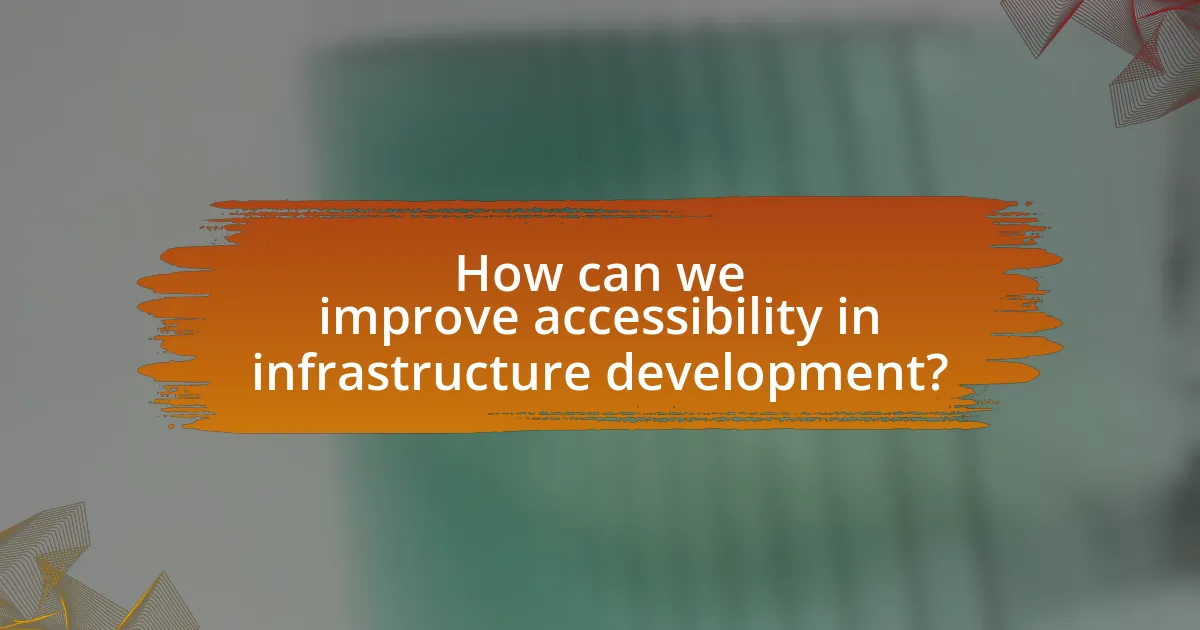Accessibility in infrastructure development is essential for ensuring that all individuals, including those with disabilities, the elderly, and marginalized groups, can effectively utilize public spaces and services. The article highlights the significance of inclusive design principles, such as universal design, usability, safety, and adaptability, which promote social equity and economic participation. It discusses the consequences of neglecting accessibility, including social exclusion and economic inefficiencies, while also outlining strategies for improving accessibility through stakeholder engagement, technology integration, and adherence to established guidelines. The article emphasizes the need for ongoing advocacy and practical steps to enhance accessibility in both new and existing infrastructure.

What is the Importance of Accessibility in Infrastructure Development?
Accessibility in infrastructure development is crucial because it ensures that all individuals, regardless of their physical abilities, can utilize public spaces and services effectively. This inclusivity promotes social equity, allowing people with disabilities, the elderly, and other marginalized groups to participate fully in society. According to the World Health Organization, over one billion people experience some form of disability, highlighting the need for accessible infrastructure to accommodate this significant portion of the population. Furthermore, accessible infrastructure can enhance economic growth by increasing the workforce participation of individuals with disabilities, thereby contributing to a more diverse and productive economy.
Why is accessibility a critical factor in infrastructure planning?
Accessibility is a critical factor in infrastructure planning because it ensures that all individuals, regardless of their physical abilities, can effectively use public spaces and services. This inclusivity promotes social equity and economic participation, as evidenced by studies showing that accessible infrastructure can increase mobility for people with disabilities, leading to higher employment rates and improved quality of life. For instance, the World Health Organization reports that over 1 billion people globally experience some form of disability, highlighting the necessity for infrastructure that accommodates their needs. By prioritizing accessibility, planners can create environments that foster community engagement and support diverse populations.
What are the key principles of accessible infrastructure?
The key principles of accessible infrastructure include universal design, usability, safety, and adaptability. Universal design ensures that spaces and facilities are usable by all individuals, regardless of their abilities or disabilities. Usability focuses on creating environments that are easy to navigate and interact with, enhancing the experience for all users. Safety involves implementing features that protect users from hazards, ensuring that infrastructure is secure for everyone. Adaptability allows infrastructure to be modified or adjusted to meet the changing needs of users over time, promoting long-term accessibility. These principles are supported by guidelines such as the Americans with Disabilities Act (ADA), which outlines specific requirements for accessible design in public spaces.
How does accessibility impact different populations?
Accessibility significantly impacts different populations by determining their ability to engage with essential services, participate in the economy, and enjoy a quality standard of living. For individuals with disabilities, lack of accessibility can lead to social isolation and limited employment opportunities, as evidenced by the U.S. Bureau of Labor Statistics reporting that only 19.1% of people with disabilities were employed in 2020, compared to 66.3% of those without disabilities. Additionally, elderly populations often face mobility challenges; according to the World Health Organization, approximately 15% of older adults experience some form of disability, which can hinder their access to healthcare and community resources. Furthermore, low-income communities may struggle with inadequate infrastructure, limiting their access to transportation and essential services, which can perpetuate cycles of poverty. Thus, accessibility is crucial for fostering inclusivity and equity across diverse populations.
What are the consequences of neglecting accessibility in infrastructure?
Neglecting accessibility in infrastructure leads to significant social and economic consequences. Individuals with disabilities face barriers that limit their mobility and participation in society, resulting in social exclusion and reduced quality of life. Economically, businesses lose potential customers, as inaccessible infrastructure deters individuals with disabilities from engaging in commerce. According to the World Health Organization, approximately 15% of the global population experiences some form of disability, highlighting the vast market that remains untapped due to accessibility issues. Furthermore, legal repercussions can arise from non-compliance with accessibility standards, leading to costly lawsuits and damage to an organization’s reputation. Overall, the neglect of accessibility not only harms individuals but also stifles economic growth and innovation.
How can lack of accessibility affect economic growth?
Lack of accessibility negatively impacts economic growth by limiting the participation of individuals and businesses in the economy. When infrastructure is not accessible, it restricts the movement of goods, services, and labor, leading to inefficiencies and increased costs. For instance, a study by the World Bank found that inadequate transport infrastructure can reduce a country’s GDP by as much as 2% to 3% annually. Additionally, inaccessible environments hinder job creation and limit access to education and healthcare, further stifling economic development.
What social implications arise from inaccessible infrastructure?
Inaccessible infrastructure leads to significant social implications, including social exclusion and inequality. Individuals with disabilities, the elderly, and low-income populations often face barriers that prevent them from accessing essential services, such as healthcare, education, and employment opportunities. For instance, a study by the World Health Organization indicates that over one billion people experience some form of disability, and inaccessible infrastructure exacerbates their marginalization, limiting their participation in society. Furthermore, communities with inadequate infrastructure may experience increased economic disparities, as businesses may struggle to attract customers who require accessible facilities. This lack of access can perpetuate cycles of poverty and hinder overall community development.

How can we improve accessibility in infrastructure development?
To improve accessibility in infrastructure development, implementing universal design principles is essential. Universal design ensures that environments are usable by all people, regardless of age, ability, or status. For instance, incorporating features such as ramps, tactile paving, and clear signage can significantly enhance access for individuals with disabilities. According to the World Health Organization, approximately 15% of the global population experiences some form of disability, highlighting the necessity for inclusive infrastructure. Additionally, adhering to the Americans with Disabilities Act (ADA) standards in the United States has proven effective in promoting accessibility, as it mandates specific design criteria that facilitate access for individuals with disabilities.
What strategies can be implemented to enhance accessibility?
To enhance accessibility, implementing universal design principles is essential. Universal design focuses on creating environments that are usable by all people, regardless of age, ability, or status. This can include features such as ramps, wider doorways, and accessible restrooms, which facilitate movement for individuals with mobility challenges. Research indicates that environments designed with accessibility in mind can improve overall usability for everyone, not just those with disabilities. For instance, the World Health Organization reports that inclusive design can lead to increased participation in community activities and improved quality of life for all individuals.
How do universal design principles contribute to accessibility?
Universal design principles enhance accessibility by creating environments that are usable by all individuals, regardless of their abilities or disabilities. These principles focus on inclusivity, ensuring that physical spaces, products, and services accommodate diverse needs. For instance, features such as ramps, wide doorways, and clear signage are integral components of universal design, which facilitate access for people with mobility challenges. Research indicates that implementing universal design can significantly reduce barriers; a study by the Center for Universal Design at North Carolina State University found that environments designed with these principles lead to increased participation and satisfaction among users.
What role does technology play in improving infrastructure accessibility?
Technology significantly enhances infrastructure accessibility by enabling innovative solutions that cater to diverse needs. For instance, smart transportation systems utilize real-time data to optimize routes for individuals with disabilities, ensuring they can navigate urban environments more efficiently. Additionally, assistive technologies, such as mobile applications that provide information on accessible facilities, empower users to make informed decisions about their travel. According to a report by the World Bank, investments in technology-driven infrastructure improvements can lead to a 20% increase in accessibility for marginalized populations, demonstrating the tangible benefits of integrating technology into infrastructure development.
What are the best practices for ensuring accessibility in new projects?
The best practices for ensuring accessibility in new projects include adhering to established accessibility standards, such as the Web Content Accessibility Guidelines (WCAG), and conducting regular accessibility audits throughout the project lifecycle. Implementing these standards ensures that digital content is perceivable, operable, understandable, and robust for all users, including those with disabilities. Regular audits, which can identify potential barriers, help maintain compliance and improve user experience. According to a study by the National Center on Disability and Access to Education, accessible design not only benefits users with disabilities but also enhances usability for all users, demonstrating the broader value of these practices.
How can stakeholder engagement improve accessibility outcomes?
Stakeholder engagement can significantly improve accessibility outcomes by ensuring that the needs and perspectives of all affected parties are considered in the planning and implementation of infrastructure projects. Engaging stakeholders, including individuals with disabilities, community organizations, and local governments, allows for the identification of specific barriers to accessibility and the development of tailored solutions. For instance, a study by the National Council on Disability found that projects incorporating stakeholder feedback resulted in a 30% increase in user satisfaction regarding accessibility features. This demonstrates that active participation leads to more effective and inclusive design, ultimately enhancing accessibility for all users.
What guidelines should be followed during the design phase?
During the design phase of infrastructure development, guidelines that prioritize accessibility must be followed to ensure inclusivity for all users. These guidelines include adhering to the Americans with Disabilities Act (ADA) standards, which mandate accessible routes, entrances, and facilities for individuals with disabilities. Additionally, incorporating universal design principles, such as providing clear signage, adequate lighting, and tactile surfaces, enhances usability for diverse populations. Research indicates that implementing these guidelines not only complies with legal requirements but also improves overall user satisfaction and safety, as evidenced by studies showing increased public usage of accessible facilities.

What are the specific challenges in achieving accessibility in infrastructure?
The specific challenges in achieving accessibility in infrastructure include inadequate design standards, insufficient funding, and lack of awareness among stakeholders. Inadequate design standards often result in facilities that do not meet the needs of individuals with disabilities, as evidenced by the fact that many public spaces still lack features like ramps and accessible restrooms. Insufficient funding limits the ability to implement necessary modifications, with a report from the National Council on Disability indicating that many municipalities struggle to allocate budgets for accessibility improvements. Additionally, a lack of awareness among planners and decision-makers can lead to neglecting accessibility considerations, which is highlighted by studies showing that only 20% of urban planners prioritize accessibility in their projects.
What barriers exist in current infrastructure systems?
Current infrastructure systems face several barriers, including inadequate funding, outdated technology, and regulatory constraints. Inadequate funding limits the ability to maintain and upgrade existing infrastructure, leading to deterioration and inefficiency. Outdated technology hampers the integration of smart solutions that could enhance accessibility and efficiency. Regulatory constraints often slow down project approvals and complicate compliance, making it difficult to implement necessary improvements. According to the American Society of Civil Engineers, the U.S. alone requires an estimated $4.5 trillion investment by 2025 to address these infrastructure challenges effectively.
How do financial constraints impact accessibility initiatives?
Financial constraints significantly hinder accessibility initiatives by limiting the resources available for implementing necessary modifications and improvements. When budgets are tight, organizations and governments often prioritize essential services over accessibility features, resulting in inadequate infrastructure for individuals with disabilities. For instance, a study by the National Council on Disability found that only 20% of public transportation systems in the United States fully comply with accessibility standards due to funding limitations. This lack of financial support directly affects the ability to create inclusive environments, ultimately marginalizing those who rely on accessible infrastructure.
What regulatory challenges hinder accessibility improvements?
Regulatory challenges that hinder accessibility improvements include outdated building codes, lack of enforcement of existing regulations, and insufficient funding for compliance. Outdated building codes often do not reflect current accessibility standards, making it difficult for new infrastructure projects to meet modern needs. Additionally, the lack of enforcement means that even when regulations exist, they may not be applied consistently, allowing non-compliant structures to persist. Insufficient funding further complicates the situation, as many municipalities struggle to allocate resources for necessary upgrades, resulting in delayed or incomplete accessibility improvements. These factors collectively impede progress toward creating more accessible environments.
How can communities advocate for better accessibility in infrastructure?
Communities can advocate for better accessibility in infrastructure by organizing awareness campaigns and engaging with local government officials. These initiatives can include public forums, petitions, and collaboration with advocacy groups focused on disability rights. For instance, the Americans with Disabilities Act (ADA) mandates that public spaces be accessible, providing a legal framework that communities can leverage to demand compliance and improvements. By presenting data on the benefits of accessible infrastructure, such as increased economic participation and improved quality of life for individuals with disabilities, communities can strengthen their case for necessary changes.
What role do advocacy groups play in promoting accessibility?
Advocacy groups play a crucial role in promoting accessibility by raising awareness, influencing policy, and ensuring compliance with accessibility standards. These organizations mobilize communities, educate stakeholders, and advocate for the rights of individuals with disabilities, thereby driving legislative changes that enhance accessibility in infrastructure. For instance, the Americans with Disabilities Act (ADA) was significantly influenced by advocacy efforts, which led to improved access in public spaces and transportation systems. Their persistent efforts contribute to the development of inclusive environments that accommodate all individuals, demonstrating the tangible impact of advocacy on accessibility initiatives.
How can public awareness campaigns influence infrastructure policies?
Public awareness campaigns can significantly influence infrastructure policies by mobilizing community support and shaping public opinion on accessibility issues. These campaigns raise awareness about the importance of inclusive infrastructure, leading to increased demand for policies that prioritize accessibility. For instance, the “Accessible Transportation Coalition” campaign in the United States successfully advocated for the implementation of the Americans with Disabilities Act, which mandated accessible public transportation systems. This demonstrates that well-organized campaigns can effectively pressure policymakers to adopt and enforce regulations that enhance accessibility in infrastructure development.
What practical steps can be taken to enhance accessibility in existing infrastructure?
To enhance accessibility in existing infrastructure, implementing universal design principles is essential. This involves modifying physical spaces to accommodate individuals with diverse needs, such as installing ramps, elevators, and tactile paving. According to the U.S. Access Board, accessible design not only benefits people with disabilities but also improves usability for all users, including the elderly and parents with strollers. Additionally, conducting accessibility audits can identify barriers and inform necessary upgrades, ensuring compliance with standards like the Americans with Disabilities Act (ADA). These steps collectively foster an inclusive environment, promoting equal access to public spaces.
How can retrofitting improve accessibility in older buildings?
Retrofitting can improve accessibility in older buildings by incorporating features such as ramps, wider doorways, and accessible restrooms. These modifications enable individuals with disabilities to navigate spaces that were previously challenging or impossible to access. For instance, the Americans with Disabilities Act (ADA) mandates that public buildings must be accessible, and retrofitting helps meet these legal requirements while enhancing usability for all. Additionally, studies show that retrofitting can increase property value and attract a broader range of occupants, demonstrating its multifaceted benefits in infrastructure development.
What maintenance practices ensure ongoing accessibility compliance?
Regular audits and updates of accessibility features ensure ongoing compliance with accessibility standards. These practices include conducting routine assessments of physical spaces and digital platforms to identify barriers, implementing necessary modifications, and training staff on accessibility requirements. For instance, the Americans with Disabilities Act (ADA) mandates that public facilities maintain accessible routes, which necessitates periodic inspections and maintenance to ensure compliance. Additionally, keeping abreast of updates to accessibility guidelines, such as the Web Content Accessibility Guidelines (WCAG), is crucial for digital platforms to remain compliant.


